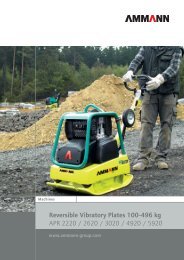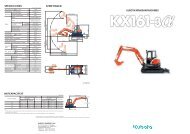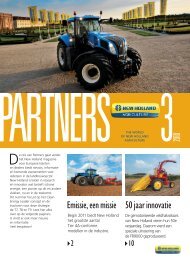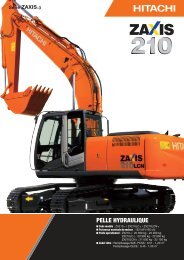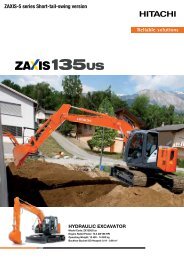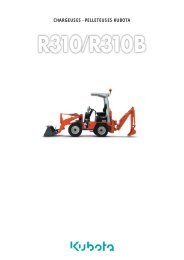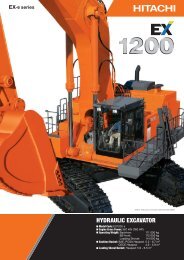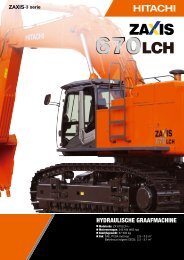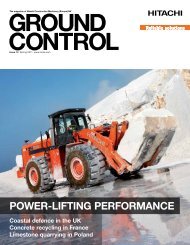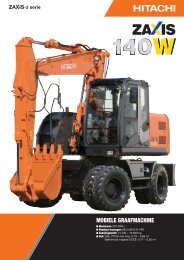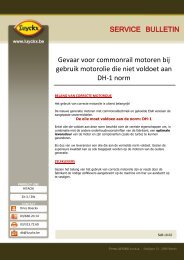Powersystems ⢠Industrial Engines Maintenance and Repair - Luyckx
Powersystems ⢠Industrial Engines Maintenance and Repair - Luyckx
Powersystems ⢠Industrial Engines Maintenance and Repair - Luyckx
Create successful ePaper yourself
Turn your PDF publications into a flip-book with our unique Google optimized e-Paper software.
<strong>Powersystems</strong> • <strong>Industrial</strong> <strong>Engines</strong><br />
<strong>Maintenance</strong> <strong>and</strong> <strong>Repair</strong><br />
Series 457, 500 <strong>and</strong> 900<br />
Advanced Training<br />
As at 04/03<br />
<strong>Powersystems</strong> • <strong>Industrial</strong> <strong>Engines</strong><br />
<strong>Maintenance</strong> <strong>and</strong> <strong>Repair</strong> Series 457,<br />
500 d 900 Ad d T i i
This document is provided for training purposes only <strong>and</strong> is not subject to the normal updates.<br />
Printed in Germany<br />
2003 Copyright DaimlerChrysler AG<br />
Herausgeber: Global Training<br />
This documentation <strong>and</strong> all its constituent parts are subject to copyright. Any reproduction or reuse<br />
requires written permission from DaimlerChrysler AG in advance. This especially applies to<br />
any duplication, dissemination, editing, translation, <strong>and</strong> microfilming of this documentation, or<br />
storage <strong>and</strong>/or processing on electronic systems, databases <strong>and</strong> online services.<br />
Note:<br />
The term "employee" always refers to both<br />
male <strong>and</strong> female staff.<br />
1511 1209 02 - 1 st edition 04.03 236 As at 04/03
Content 07.05.2003<br />
Title<br />
Side<br />
Welcome ..................................................................................................................................................................................................................................................1<br />
Engine model series OM 457 LA..............................................................................................................................................................................................................2<br />
Engine OM 457 LA ...................................................................................................................................................................................................................................4<br />
Series 457Cylinder head....................................................................................................................................................................................................................11<br />
Series 457Cylinder head - cross section (transverse <strong>and</strong> longitudinal) ............................................................................................................................................12<br />
Series 457 LAPort assignments in the cylinder head gasket ............................................................................................................................................................13<br />
Series 457Cylinder head bolts - tightening instructions....................................................................................................................................................................14<br />
Series 457Setting valve play .............................................................................................................................................................................................................16<br />
Series 457Removing/installing the nozzle holder combination........................................................................................................................................................19<br />
Series 457Valve cover <strong>and</strong> valve cover gasket .................................................................................................................................................................................25<br />
Series 457Oil pan ..............................................................................................................................................................................................................................26<br />
Series 457Pump-line-nozzle injection system ...................................................................................................................................................................................27<br />
Series 457Removing/installing the MR/PLD unit pump...................................................................................................................................................................28<br />
Series 457Pistons..............................................................................................................................................................................................................................35<br />
Series 457Lubrication schematic diagram ........................................................................................................................................................................................36<br />
Series 457Oil spray nozzle.................................................................................................................................................................................................................38<br />
Series 457Crankcase <strong>and</strong> cylinder liner ............................................................................................................................................................................................39<br />
Series 457Camshaft ..........................................................................................................................................................................................................................40<br />
05/03 <strong>Powersystems</strong> • <strong>Industrial</strong> <strong>Engines</strong> <strong>Maintenance</strong> <strong>and</strong> <strong>Repair</strong> Series 457, 500 <strong>and</strong> 900 Advanced Training<br />
Content I 1
Series 457Fuel system ......................................................................................................................................................................................................................42<br />
Series 457Fuel pump.........................................................................................................................................................................................................................45<br />
Series 457Fuel prefilter with heated water separator.......................................................................................................................................................................46<br />
Series 457Planetary drive starter ......................................................................................................................................................................................................48<br />
Series 457Fan drive <strong>and</strong> fan systems................................................................................................................................................................................................50<br />
Series 457Air compressor .................................................................................................................................................................................................................52<br />
Series 457Turbocharger BR S400 .....................................................................................................................................................................................................53<br />
Series 457Engine oil <strong>and</strong> filter change ..............................................................................................................................................................................................54<br />
Series 457Replacing the fuel filter ....................................................................................................................................................................................................56<br />
Series 457Fuel filter with water separator - replacing the filter element..........................................................................................................................................58<br />
Series 457Air cleaner, engine coolant service ..................................................................................................................................................................................60<br />
Series 500Engine models ..................................................................................................................................................................................................................62<br />
Series 500Technical features ............................................................................................................................................................................................................64<br />
Series 500Cylinder head - port assignment ......................................................................................................................................................................................70<br />
Series 500Cylinder head....................................................................................................................................................................................................................71<br />
Series 500Cylinder head mounting ...................................................................................................................................................................................................73<br />
Series 500Cylinder head gasket........................................................................................................................................................................................................74<br />
Series 500EURO 2 <strong>and</strong> EURO 3 cylinder heads compared ...............................................................................................................................................................75<br />
Series 500Valve assembly.................................................................................................................................................................................................................77<br />
Series 500Pump-line-nozzle injection system (PLD) .........................................................................................................................................................................83<br />
Series 500Removing/installing the MR/PLD unit pump...................................................................................................................................................................91<br />
Series 500EURO 2 <strong>and</strong> EURO 3 pistons ......................................................................................................................................................................................... 101<br />
05/03 <strong>Powersystems</strong> • <strong>Industrial</strong> <strong>Engines</strong> <strong>Maintenance</strong> <strong>and</strong> <strong>Repair</strong> Series 457, 500 <strong>and</strong> 900 Advanced Training<br />
Content I 2
Welcome 07.05.2003<br />
OM 457 LA OM 502 LA OM 906 LA<br />
N01.10-2073-50 N01.10-0341-50 N01.00-2301-50<br />
05/03 <strong>Powersystems</strong> • <strong>Industrial</strong> <strong>Engines</strong> <strong>Maintenance</strong> <strong>and</strong> <strong>Repair</strong> Series 457, 500 <strong>and</strong> 900 Advanced Training<br />
Welcome 1
Engine model series OM 457 LA 07.05.2003<br />
Serie 457<br />
6 cylinder in line engine<br />
OM 457 LA<br />
V H = 12l<br />
PPT<br />
05/03 <strong>Powersystems</strong> • <strong>Industrial</strong> <strong>Engines</strong> <strong>Maintenance</strong> <strong>and</strong> <strong>Repair</strong> Series 457, 500 <strong>and</strong> 900 Advanced Training<br />
Engine model series OM 457 LA 2
Engine 457 LA<br />
W01.00-1021-06<br />
05/03 <strong>Powersystems</strong> • <strong>Industrial</strong> <strong>Engines</strong> <strong>Maintenance</strong> <strong>and</strong> <strong>Repair</strong> Series 457, 500 <strong>and</strong> 900 Advanced Training<br />
Engine model series OM 457 LA 3
Engine OM 457 LA 07.05.2003<br />
Characteristics:<br />
Engine model series OM 457 LA is a new development with optimized power output <strong>and</strong> torque<br />
characteristics.<br />
These engines are suitable for all operational fields in the On/Off-highway modes.<br />
They are characterized by high economy with low fuel consumption <strong>and</strong> low service requirements.<br />
With its low power/weight ratio, the engine design corresponds to the dem<strong>and</strong>s of the market.<br />
Other features of the new engine model series are high reliability in association with long runtime, with<br />
low fuel consumption for optimal power output.<br />
N01.10-2082-01<br />
Main technical characteristics of the BR 457:<br />
<br />
<br />
<br />
<br />
<br />
<br />
<br />
High-strength, noise-optimised cylinder housing of high-additive cast iron.<br />
Compact design <strong>and</strong> high functional reliability through integration of the oil cooler, the unit pumps, <strong>and</strong> the coolant, fuel <strong>and</strong> oil ports into the crankcase.<br />
<strong>Engines</strong> in three different power categories, which already correspond to the EURO III or Euromot/EPA Level 2 st<strong>and</strong>ard from the start of production.<br />
Highly rigid oil pan of light alloy.<br />
Seven-journal crankshaft with counterweights bolted on. Induction-hardened bearing points <strong>and</strong> fillet radius.<br />
Fitted bearing located at the central bearing support for technical reasons related to vibrations.<br />
Main <strong>and</strong> connecting rod bearings consists of three-compound friction bearings. The thrust side is divided (last running layer is vacuum-metalized).<br />
05/03 <strong>Powersystems</strong> • <strong>Industrial</strong> <strong>Engines</strong> <strong>Maintenance</strong> <strong>and</strong> <strong>Repair</strong> Series 457, 500 <strong>and</strong> 900 Advanced Training<br />
Engine OM 457 LA 4
Crankshaft seal of radial sealing rings with nonwoven dust lip.<br />
Camshaft drive through flywheel side gear drive.<br />
Gear-driven air compressor with flange-mounted power steering pump located flywheel side.<br />
Fuel delivery pump driven by a camshaft on the belt side.<br />
Oil pump in the oil pan, driven by gears on the flywheel side.<br />
<strong>Maintenance</strong> free poly-V-belt drive for all assemblies.<br />
Planetary gear drive starter on right at the flywheel.<br />
MR control unit with additional fuel cooler.<br />
Intake valve seat rings of Tribaloy, a high-carbon tungsten/steel alloy. These have to be smoothed when installed.<br />
Heat protection sleeve similar to BR 906 <strong>and</strong> BR 500.<br />
Piston cooling though oil spray nozzles.<br />
Camshaft/unit pump lubrication through additional oil spray nozzles.<br />
Four-valve technology with 2 intake <strong>and</strong> 2 exhaust valves per cylinder.<br />
MR engine control with the engine electronics located directly on the engine.<br />
Pump-line-nozzle system with solenoid-controlled unit pumps.<br />
Electronically controlled high-pressure direct injection at 1800 bar.<br />
Direct injection with centrally positioned 6-hole injection nozzle.<br />
Engine brake with exhaust flap <strong>and</strong> pneumatically controlled constant throttle valve. The useful engine speed range is above rated rpms.<br />
Turbocharger with charge air cooling.<br />
Turbobrake as special equipment.<br />
Engine power take-off at rear, also possible at front by means of additional belt drive for ancillary assemblies (special equipment).<br />
Can operate with biodiesel (RME).<br />
05/03 <strong>Powersystems</strong> • <strong>Industrial</strong> <strong>Engines</strong> <strong>Maintenance</strong> <strong>and</strong> <strong>Repair</strong> Series 457, 500 <strong>and</strong> 900 Advanced Training<br />
Engine OM 457 LA 5
N01.10-2059-50<br />
N01.10-2060-50<br />
05/03 <strong>Powersystems</strong> • <strong>Industrial</strong> <strong>Engines</strong> <strong>Maintenance</strong> <strong>and</strong> <strong>Repair</strong> Series 457, 500 <strong>and</strong> 900 Advanced Training<br />
Engine OM 457 LA 6
Overview of engines with EURO 3 certification<br />
Engine model No. of cylinders/Location Power output<br />
(engine speed)<br />
[kW/HP (at rpm)]<br />
Torque (engine speed)<br />
[kW/HP (at rpm)]<br />
Cylinder bore<br />
(mm)<br />
Cylinder<br />
stroke (mm)<br />
Displacement (l)<br />
OM 457 LA 6 cylinder / in-line 185/252 (2000) 1100 (1100) 128 155 11.97<br />
OM 457 LA 6 cylinder / in-line 220/299 (2000) 1250 (1100) 128 155 11.97<br />
OM 457 LA 6 cylinder / in-line 260/354 (2000) 1600 (1100) 128 155 11.97<br />
OM 457 LA 6 cylinder / in-line 260/354 (2000) 1750 (1100) 128 155 11.97<br />
OM 457 LA 6 cylinder / in-line 260/354 (1900) 1850 (1100) 128 155 11.97<br />
OM 457 LA 6 cylinder / in-line 295/401 (1900) 2000 (1100) 128 155 11.97<br />
OM 457 LA 6 cylinder / in-line 310/421 (2000) 1900 (1100) 128 155 11.97<br />
OM 457 LA 6 cylinder / in-line 315/428 (1900) 2100 (1100) 128 155 11.97<br />
OM 457 hLA 6 cylinder / horizontal 185/253 (2000) 1100 (1100) 128 155 11.97<br />
OM 457 hLA 6 cylinder / horizontal 220/299 (2000) 1250 (1100) 128 155 11.97<br />
OM 457 hLA 6 cylinder / horizontal 260/354 (2000) 1600 (1100) 128 155 11.97<br />
OM 457 hLA 6 cylinder / horizontal 300/408 (2000) 1900 (1100) 128 155 11.97<br />
Overview of engines with EUROMOT/EPA Level 2 certification<br />
Engine model No. of cylinders/ layout Power output<br />
(engine speed)<br />
[kW/HP (at rpm)]<br />
Torque (engine speed)<br />
[kW/HP (at rpm)]<br />
Cylinder bore<br />
(mm)<br />
Cylinder<br />
stroke (mm)<br />
Displacement (l)<br />
OM 457 LA 6 cylinder / in-line 242/329 (1800) 1600 (1200) 128 155 11.97<br />
OM 457 LA 6 cylinder / in-line 260/354 (1800) 1750 (1200) 128 155 11.97<br />
OM 457 LA 6 cylinder / in-line 295/401 (1800) 1900 (1200) 128 155 11.97<br />
OM 457 LA 6 cylinder / in-line 315/428 (1800) 2000 (1200) 128 155 11.97<br />
OM 457 LA 6 cylinder / in-line 335/455 (1800) 2000 (1200) 128 155 11.97<br />
05/03 <strong>Powersystems</strong> • <strong>Industrial</strong> <strong>Engines</strong> <strong>Maintenance</strong> <strong>and</strong> <strong>Repair</strong> Series 457, 500 <strong>and</strong> 900 Advanced Training<br />
Engine OM 457 LA 7
Location of components:<br />
Legend:<br />
1 Starter<br />
2 Turbocharger with throttle valve<br />
3 Refrigerant compressor<br />
4 Oil filter / oil cooler combination<br />
5 Alternator<br />
6 Belt tensioner<br />
2<br />
4<br />
5<br />
1<br />
6<br />
3<br />
GT01.00-0003-05<br />
05/03 <strong>Powersystems</strong> • <strong>Industrial</strong> <strong>Engines</strong> <strong>Maintenance</strong> <strong>and</strong> <strong>Repair</strong> Series 457, 500 <strong>and</strong> 900 Advanced Training<br />
Engine OM 457 LA 8
Legend:<br />
1 Fuel filter<br />
2 Flame starting system<br />
3 Retarder return flow<br />
4 Retarder feed<br />
5 Oil replenishment<br />
6 Oil dipstick<br />
7 MR PLD control module<br />
8 Control connections<br />
9 ZKG ventilation with oil vapor separator<br />
10 Single-cylinder air compressor<br />
11 Power steering unit pump<br />
12 Oil pump (in oil pan)<br />
13 Fuel pump<br />
1<br />
2<br />
3<br />
4<br />
5<br />
6<br />
7<br />
8<br />
9<br />
10<br />
11<br />
13<br />
12<br />
GT01.00-0002-05<br />
05/03 <strong>Powersystems</strong> • <strong>Industrial</strong> <strong>Engines</strong> <strong>Maintenance</strong> <strong>and</strong> <strong>Repair</strong> Series 457, 500 <strong>and</strong> 900 Advanced Training<br />
Engine OM 457 LA 9
05/03 <strong>Powersystems</strong> • <strong>Industrial</strong> <strong>Engines</strong> <strong>Maintenance</strong> <strong>and</strong> <strong>Repair</strong> Series 457, 500 <strong>and</strong> 900 Advanced Training<br />
Engine OM 457 LA 10
Series 457Cylinder head 07.05.2003<br />
GT01.30-0002-12<br />
GT01.30-0001-12<br />
The six individual cylinder heads are of cast iron, each fixed to the crankcase with four stretch-shank bolts.<br />
The package of design <strong>and</strong> technology measures already present in the BR 500 engine model series has been carried over for the cylinder heads of this model<br />
series, in order to meet the EURO III St<strong>and</strong>ards. The 6-hole injection nozzles are located centrally in the combustion chamber. Two intake <strong>and</strong> outlet valves are<br />
arranged symmetrically around each of these, so that the optimal conditions are present for gas exchange that is rapid <strong>and</strong> as complete as possible.<br />
This has a positive effect on fuel consumption <strong>and</strong> exhaust gas composition.<br />
The valves are controlled from the camshaft through pairs of push rods, rocker arms <strong>and</strong> valve bridges.<br />
05/03 <strong>Powersystems</strong> • <strong>Industrial</strong> <strong>Engines</strong> <strong>Maintenance</strong> <strong>and</strong> <strong>Repair</strong> Series 457, 500 <strong>and</strong> 900 Advanced Training<br />
Series 457Cylinder head 11
Series 457Cylinder head - cross section (transverse <strong>and</strong> longitudinal) 07.05.2003<br />
N03.10-2056-12<br />
N01.10-2079-11<br />
Each cylinder head has two intake <strong>and</strong> exhaust valves, one pneumatically-operated constant throttle, <strong>and</strong> the nozzle holder combination with pressure<br />
connection.<br />
05/03 <strong>Powersystems</strong> • <strong>Industrial</strong> <strong>Engines</strong> <strong>Maintenance</strong> <strong>and</strong> <strong>Repair</strong> Series 457, 500 <strong>and</strong> 900 Advanced Training<br />
Series 457Cylinder head - cross section (transverse <strong>and</strong> longitudinal) 12
Series 457 LAPort assignments in the cylinder head gasket 07.05.2003<br />
C<br />
E<br />
A<br />
E<br />
B<br />
B<br />
A<br />
B<br />
C<br />
D<br />
E<br />
Coolant<br />
Bolts<br />
Pressure oil<br />
Oil return<br />
Plunger, oil return<br />
B<br />
A<br />
D<br />
B<br />
N01.30-2068-12<br />
05/03 <strong>Powersystems</strong> • <strong>Industrial</strong> <strong>Engines</strong> <strong>Maintenance</strong> <strong>and</strong> <strong>Repair</strong> Series 457, 500 <strong>and</strong> 900 Advanced Training<br />
Series 457 LAPort assignments in the cylinder head gasket 13
Series 457Cylinder head bolts - tightening instructions 07.05.2003<br />
Cylinder head bolt test values<br />
Designation Engine 457.9<br />
Cylinder head bolt M 15 x 2 Shank length [mm] 212<br />
Cylinder head bolt tightening torques<br />
Designation Engine 457.9<br />
Cylinder head bolt to crankcase Step 1 [Nm] 10<br />
Step 2 [Nm] 50<br />
Step 3 [Nm] 100<br />
Step 4 [Nm] 200<br />
Step 5 <br />
Step 6 <br />
90<br />
90<br />
05/03 <strong>Powersystems</strong> • <strong>Industrial</strong> <strong>Engines</strong> <strong>Maintenance</strong> <strong>and</strong> <strong>Repair</strong> Series 457, 500 <strong>and</strong> 900 Advanced Training<br />
Series 457Cylinder head bolts - tightening instructions 14
Socket wrench bit<br />
422_589_01_09_00<br />
Screw in the cylinder head bolts <strong>and</strong>, following the above tightening sequence (1 to 4), tighten to the<br />
indicated torque <strong>and</strong> tightening angle.<br />
If a bolt has been over-tightened when assembling, then all four bolts should be loosened on the<br />
cylinder head concerned, examined for elongation, then tightened again starting from Step 1.<br />
The cylinder head bolts do not require any further tightening.<br />
E Intake side<br />
A Exhaust side<br />
A01.30-0003-01<br />
05/03 <strong>Powersystems</strong> • <strong>Industrial</strong> <strong>Engines</strong> <strong>Maintenance</strong> <strong>and</strong> <strong>Repair</strong> Series 457, 500 <strong>and</strong> 900 Advanced Training<br />
Series 457Cylinder head bolts - tightening instructions 15
Series 457Setting valve play 07.05.2003<br />
1 Adjusting screw<br />
2...Locknut<br />
N05.30-2071-01<br />
3...Cap<br />
4...Turning device<br />
N03.30-0313-01 Turning device 904 589 04 63 00<br />
Procedure for setting valve play<br />
Check or set the valve play with the engine cold. At least 30 minutes after stopping the engine,<br />
even after running for a short period, so that the engine will be warmed up evenly.<br />
1 Remove the cylinder head cover<br />
2 Select the valve setting method<br />
Setting according to injection sequence<br />
Method 1<br />
Setting in two crankshaft positions<br />
Method 2<br />
05/03 <strong>Powersystems</strong> • <strong>Industrial</strong> <strong>Engines</strong> <strong>Maintenance</strong> <strong>and</strong> <strong>Repair</strong> Series 457, 500 <strong>and</strong> 900 Advanced Training<br />
Series 457Setting valve play 16
3 Install turning device (4) at the inspection hole in the timing case <strong>and</strong> turn the engine<br />
to the crankshaft position for the selected setting method.<br />
4 Check <strong>and</strong> set valve play (as indicated by arrows).<br />
The valve play test tolerance applies only for<br />
checking, not setting.<br />
5 Remove turning device (4) <strong>and</strong> fit the cap to the inspection hole in the crankcase.<br />
6 Fit the cylinder head covers.<br />
Valve test values<br />
Designation Engine 457.9<br />
Valve play Intake [mm] 0.40<br />
Exhaust [mm] 0.60<br />
Test tolerance [mm] -0.10/+0.20<br />
05/03 <strong>Powersystems</strong> • <strong>Industrial</strong> <strong>Engines</strong> <strong>Maintenance</strong> <strong>and</strong> <strong>Repair</strong> Series 457, 500 <strong>and</strong> 900 Advanced Training<br />
Series 457Setting valve play 17
Valve play setting methods<br />
Engine 457<br />
A...Exhaust valve<br />
E...Intake valve<br />
X...Flywheel side<br />
A01.00-0001-01<br />
A01.00-0001-01<br />
Method 1:<br />
Set intake <strong>and</strong> exhaust valves for each cylinder,<br />
according to the injection sequence.<br />
The cylinder to be set must be at ignition TDC, the<br />
parallel cylinder at valve overlap TDC.<br />
Method 2:<br />
Set intake <strong>and</strong> exhaust valves in two crankshaft<br />
positions, as shown in the table.<br />
6-cylinder<br />
First set cylinder 6 at valve overlap TDC (cylinder<br />
1 at ignition TDC), then cylinder 1 at valve overlap<br />
TDC (cylinder 6 at ignition TDC).<br />
Engine Crankshaft position Cylinder/injection sequence Engine Crankshaft position Cylinder/valves to be set<br />
1 2 3 4 5 6<br />
6-cylinder Ignition TDC 1 5 3 6 2 4 6-cylinder Cyl. 6 valve overlap E/A E A E A -<br />
Valve overlap 6 2 4 1 5 3 Cyl. 1 valve overlap - A E A E E/A<br />
05/03 <strong>Powersystems</strong> • <strong>Industrial</strong> <strong>Engines</strong> <strong>Maintenance</strong> <strong>and</strong> <strong>Repair</strong> Series 457, 500 <strong>and</strong> 900 Advanced Training<br />
Series 457Setting valve play 18
Series 457Removing/installing the nozzle holder combination 07.05.2003<br />
W07.03-1014-11 W07.03-1015-02 GT_07_03_0003<br />
05/03 <strong>Powersystems</strong> • <strong>Industrial</strong> <strong>Engines</strong> <strong>Maintenance</strong> <strong>and</strong> <strong>Repair</strong> Series 457, 500 <strong>and</strong> 900 Advanced Training<br />
Series 457Removing/installing the nozzle holder combination 19
1 Pressure screw<br />
2 Pressure pipe connection<br />
3 O-ring<br />
4 Screw<br />
5 Retaining clip<br />
7 Nozzle holder combination<br />
8 Cap<br />
9 O-ring<br />
10 Sealing sleeve<br />
L Shank length<br />
20.1 Mounting (for nozzle holder head)<br />
20.2 Press-on sleeve (for sealing sleeve)<br />
W07.03-1016-01<br />
Removal<br />
<br />
To remove<br />
1 Remove the charge air manifold<br />
2 Remove the cylinder head cover<br />
Danger! Risk of explosion due to ignition of flammable gases, Fire, sparks, naked flames, smoking are<br />
Risk of poisoning by inhaling or absorbing fuel, <strong>and</strong><br />
forbidden.<br />
Risk of injury if fuel comes into contact with skin or eyes<br />
Only store fuel in suitable <strong>and</strong><br />
correctly marked containers.<br />
3 Remove the injection lines<br />
Wear protective clothing if coming into contact with<br />
fuel.<br />
05/03 <strong>Powersystems</strong> • <strong>Industrial</strong> <strong>Engines</strong> <strong>Maintenance</strong> <strong>and</strong> <strong>Repair</strong> Series 457, 500 <strong>and</strong> 900 Advanced Training<br />
Series 457Removing/installing the nozzle holder combination 20
4 Unscrew pressure screw (1) <strong>and</strong><br />
take out pressure pipe connection (2).<br />
5 Unscrew retaining clip (5)<br />
6 Take out nozzle holder combination (7)<br />
7 Detach sealing sleeve (10) from nozzle holder<br />
combination (7)<br />
Fit the adapter <strong>and</strong> extractor to<br />
inside thread (M8) of the nozzle holder<br />
combination.<br />
<br />
<br />
The nozzle holder combination should not be<br />
disassembled.<br />
If worn or faulty, install new<br />
nozzle holder combination.<br />
If the sealing sleeve is stuck:<br />
pull sealing sleeve out of cylinder head<br />
Extracting tool<br />
Threaded insert<br />
Extractor<br />
Installation<br />
<br />
To install<br />
8 Replace O-ring (9) on nozzle holder combination (7)<br />
05/03 <strong>Powersystems</strong> • <strong>Industrial</strong> <strong>Engines</strong> <strong>Maintenance</strong> <strong>and</strong> <strong>Repair</strong> Series 457, 500 <strong>and</strong> 900 Advanced Training<br />
Series 457Removing/installing the nozzle holder combination 21
9 Press new sealing sleeve (10) onto the nozzle holder combination (7)<br />
10 Install nozzle holder combination (7)<br />
11 Screw on the retaining clip (5)<br />
12 Place a new O-ring (3) on pressure pipe connection (2).<br />
13 Mount the pressure pipe connection (2) <strong>and</strong><br />
tighten pressure screw (1).<br />
<br />
Before pressing on the new<br />
sealing sleeve, clean the contact surface of<br />
the sealing sleeve to remove combustion residues<br />
(using a wire brush for example, or<br />
ultrasonic cleaning equipment):<br />
Clean the nozzle holder combination<br />
Note installation location of nozzle holder<br />
combination<br />
at pressure pipe connection hole.<br />
Note installation location<br />
<br />
Check the shank length of screws (4).<br />
Grease the O-ring (3).<br />
<br />
14 Install the injection lines<br />
15 Fit the cylinder head cover<br />
16 Fit the charge air manifold.<br />
05/03 <strong>Powersystems</strong> • <strong>Industrial</strong> <strong>Engines</strong> <strong>Maintenance</strong> <strong>and</strong> <strong>Repair</strong> Series 457, 500 <strong>and</strong> 900 Advanced Training<br />
Series 457Removing/installing the nozzle holder combination 22
Injection nozzle test/setting values<br />
Designation Engine 457.9<br />
Screw, nozzle holder combination retaining clip<br />
/constant throttle to cylinder head<br />
Shank length [mm]<br />
91<br />
Diesel injection system with unit pumps<br />
Designation Engine 457.9<br />
Pressure screw, pressure pipe connection to<br />
cylinder head<br />
Screw, injection nozzle retaining clip /<br />
constant throttle to cylinder head<br />
[Nm] 40<br />
[Nm] 40+5<br />
05/03 <strong>Powersystems</strong> • <strong>Industrial</strong> <strong>Engines</strong> <strong>Maintenance</strong> <strong>and</strong> <strong>Repair</strong> Series 457, 500 <strong>and</strong> 900 Advanced Training<br />
Series 457Removing/installing the nozzle holder combination 23
Special tools<br />
1<br />
355_589_01_63_00 904_589_00_63_00 906_589_00_63_00<br />
Remarks:<br />
1.) Extracting tool 906 589 02 63 00 is now<br />
usually supplied together with the extension.<br />
2.) From April 2003, for new orders under the<br />
existing number, special tool 906 589 00 63<br />
00 is supplied with modification to Part 1. To<br />
extend existing tools, the modified Part 1<br />
can also be ordered separately under<br />
number 906 589 00 63 01.<br />
906_589_02_63_00 Extracting tool extension 906_589_02_63_01<br />
05/03 <strong>Powersystems</strong> • <strong>Industrial</strong> <strong>Engines</strong> <strong>Maintenance</strong> <strong>and</strong> <strong>Repair</strong> Series 457, 500 <strong>and</strong> 900 Advanced Training<br />
Series 457Removing/installing the nozzle holder combination 24
Series 457Valve cover <strong>and</strong> valve cover gasket 07.05.2003<br />
GT01.30-0003-02<br />
W01.20-1008-12<br />
The six separate valve covers on the new engine development are made of special plastic (or aluminum on special request), which provides further noise<br />
reduction <strong>and</strong> optimised vibration response /resonance characteristics. To prevent deformation due to stress, the specified tightening torque for the valve cover<br />
screws must be observed scrupulously.<br />
For the cover gasket on engine OM 457, a shaped silicone rubber seal is used.<br />
These silicone rubber seals are to be fitted exclusively in conjunction with the special plastic valve covers.<br />
They can be used several times, if thoroughly cleaned <strong>and</strong> inspected. They are fitted exactly into the groove on the valve cover.<br />
05/03 <strong>Powersystems</strong> • <strong>Industrial</strong> <strong>Engines</strong> <strong>Maintenance</strong> <strong>and</strong> <strong>Repair</strong> Series 457, 500 <strong>and</strong> 900 Advanced Training<br />
Series 457Valve cover <strong>and</strong> valve cover gasket 25
Series 457Oil pan 07.05.2003<br />
The oil pan has been newly developed.<br />
It is made of high-strength aluminum alloy <strong>and</strong> is characterized by very high rigidity.<br />
When installing, the seal should be always be replaced as well.<br />
Tightening sequence <strong>and</strong> torques must be applied meticulously.<br />
Step 1 = 10 Nm<br />
Step 2 = 35 Nm<br />
W01.45-1013-06<br />
W01.45-1014-06<br />
05/03 <strong>Powersystems</strong> • <strong>Industrial</strong> <strong>Engines</strong> <strong>Maintenance</strong> <strong>and</strong> <strong>Repair</strong> Series 457, 500 <strong>and</strong> 900 Advanced Training<br />
Series 457Oil pan 26
Series 457Pump-line-nozzle injection system 07.05.2003<br />
Location of the unit pump<br />
The injection process is performed by the newly developed pump-line-nozzle system,<br />
controlled by the Telligent ® electronic engine management system.<br />
In the MR system, fuel is delivered to the injection nozzle by individual unit pumps over<br />
short, relatively rigid high-pressure injection lines, <strong>and</strong> through the pressure pipe<br />
connection screwed into the cylinder head.<br />
A unit pump fitted to the crankcase is assigned to each cylinder. This is driven by another<br />
timing cam on the camshaft. The camshaft therefore also has the task of driving the unit<br />
pumps, besides the traditional function of driving the intake <strong>and</strong> exhaust valves.<br />
The operating principle of the unit pump is based on the same principle as the piston<br />
pump, as in the in-line injection pumps used till now, but without control edges at the<br />
pump plunger.<br />
The quantity injected is determined individually per cylinder by solenoid valves, which<br />
control the start <strong>and</strong> end of injection.<br />
N07.00-0331-12<br />
05/03 <strong>Powersystems</strong> • <strong>Industrial</strong> <strong>Engines</strong> <strong>Maintenance</strong> <strong>and</strong> <strong>Repair</strong> Series 457, 500 <strong>and</strong> 900 Advanced Training<br />
Series 457Pump-line-nozzle injection system 27
Series 457Removing/installing the MR/PLD unit pump 07.05.2003<br />
W07.15-1108-09<br />
05/03 <strong>Powersystems</strong> • <strong>Industrial</strong> <strong>Engines</strong> <strong>Maintenance</strong> <strong>and</strong> <strong>Repair</strong> Series 457, 500 <strong>and</strong> 900 Advanced Training<br />
Series 457Removing/installing the MR/PLD unit pump 28
1 MR/PLD unit pump<br />
2 O-ring (black)<br />
3 O-ring (green)<br />
4 Splined bolt<br />
5 Injection line<br />
6 Engine wiring harness<br />
1 MR/PLD unit pump<br />
2 O-ring (black)<br />
3 O-ring (green)<br />
4 Protective sleeve<br />
W07.15-1107-01<br />
Removal/installation<br />
Removing/installing<br />
<br />
1 Remove the charge air manifold<br />
Danger! Risk of explosion due to ignition of flammable gases, Fire, sparks, naked flames, smoking are<br />
Risk of poisoning by inhaling or absorbing fuel, <strong>and</strong><br />
forbidden.<br />
Risk of injury if fuel comes into contact with skin or eyes<br />
Only store fuel in suitable <strong>and</strong><br />
correctly marked containers.<br />
2 Remove injection line (5)<br />
3 Remove engine wiring harness (6) at MR unit pump (1)<br />
Wear protective clothing if coming into contact with<br />
fuel.<br />
Stop up the orifices in the nozzle holder<br />
combination <strong>and</strong> the MR/PLD unit pump.<br />
<br />
To do this, loosen the screws on the solenoid<br />
valve <strong>and</strong> detach both clip fasteners.<br />
05/03 <strong>Powersystems</strong> • <strong>Industrial</strong> <strong>Engines</strong> <strong>Maintenance</strong> <strong>and</strong> <strong>Repair</strong> Series 457, 500 <strong>and</strong> 900 Advanced Training<br />
Series 457Removing/installing the MR/PLD unit pump 29
4 Identify the MR/PLD unit pump (1) for the cylinder concerned<br />
Only if removing more than one or all MR/PLD<br />
unit pumps<br />
Danger! Risk of injury to skin <strong>and</strong> eyes due to scalding, as hot Only open the cooling system at coolant<br />
coolant may spurt out.<br />
Risk of poisoning if coolant is swallowed.<br />
5 Unscrew coolant pipe from crankcase<br />
temperatures below 90°C. Turn the cap slowly<br />
<strong>and</strong> release the pressure.<br />
Do not store the coolant in drink containers.<br />
Wear protective gloves, protective clothing <strong>and</strong><br />
safety glasses.<br />
Only for the unit pumps of cylinders 1 to 3<br />
Notes on coolant<br />
<br />
6 Loosen the splined bolts (4)<br />
7 Fit the extractor to the MR/PLD unit pump (1) <strong>and</strong> pull out the MR/PLD unit pump<br />
up to the bolt heads.<br />
All engines<br />
For reasons of safety, the splined bolts<br />
should only be unscrewed by about 4-5 mm, as the<br />
MR/PLD unit pump is under spring load.<br />
Installation: Mount the MR/PLD unit pump<br />
with the splined bolts, screwing the bolts slowly<br />
into the crankcase, <strong>and</strong> tightening alternately.<br />
<br />
<br />
Firmly attached MR/PLD unit pumps should<br />
not be extracted at the solenoid valve or the<br />
housing flange.<br />
Installation: Thinly coat the unit pump body,<br />
surface of the O-rings (2, 3), <strong>and</strong> the drilling in the<br />
crankcase with lubricating grease.<br />
Insert the MR/PLD unit pump in the<br />
crankcase using the shop-made assembling<br />
pins.<br />
05/03 <strong>Powersystems</strong> • <strong>Industrial</strong> <strong>Engines</strong> <strong>Maintenance</strong> <strong>and</strong> <strong>Repair</strong> Series 457, 500 <strong>and</strong> 900 Advanced Training<br />
Series 457Removing/installing the MR/PLD unit pump 30
Assembling pins for installing the unit pump Carefully press the MR/PLD unit pump in by h<strong>and</strong><br />
against the spring load, by about 4 mm.<br />
8 Unscrew the splined bolts (4) <strong>and</strong> pull out the MR/PLD unit pump (1)<br />
9 Check the MR/PLD unit pump for scoring, scratches, <strong>and</strong> s<strong>and</strong>ing spots.<br />
10 Remove O-rings (2, 3) from the MR/PLD unit pump (1)<br />
11 Install in the reverse order<br />
If the unit pump cam is up at the camshaft, <strong>and</strong> the<br />
MR/PLD unit pump cannot be pressed<br />
in far enough, turn the engine about a revolution<br />
in the direction of rotation.<br />
Installation: Carefully clear any dirt or paint<br />
residues away from the sealing surface of the<br />
MR/PLD unit pump <strong>and</strong> the crankcase.<br />
If there is only slight scoring or scratching on<br />
the tappet roller, the MR/PLD unit pump<br />
can be used again.<br />
If there is deep scoring, scratching, or s<strong>and</strong>ing<br />
spots:<br />
Install a new MR/PLD unit pump<br />
Installation: Clean the radial groove in the unit<br />
pump body.<br />
Coat the new o-rings with lubricating grease.<br />
Push protective sleeve (8) over the unit pump body<br />
First slide the black O-ring (2) over the<br />
protective sleeve (8) into the groove, then the<br />
green O-ring (3).<br />
Avoid twisting the O-rings (2, 3) when fitting<br />
into the grooves.<br />
<br />
05/03 <strong>Powersystems</strong> • <strong>Industrial</strong> <strong>Engines</strong> <strong>Maintenance</strong> <strong>and</strong> <strong>Repair</strong> Series 457, 500 <strong>and</strong> 900 Advanced Training<br />
Series 457Removing/installing the MR/PLD unit pump 31
Unit pump classification<br />
The BR 457, 500 <strong>and</strong> 900 unit pumps are classified at manufacture.<br />
When each pump is installed in the engine on the assembly line at Mannheim,<br />
its classification is registered <strong>and</strong> stored in the MR electronic system.<br />
To ensure smooth engine running, the classification values are taken into<br />
account when distributing the fuel quantity (injection timing).<br />
To ensure that smooth engine running continues after unit pumps are replaced<br />
or modified for diagnostic purposes, the unit pump classification must be<br />
assigned to the cylinder.<br />
An input error may lead to rough engine running <strong>and</strong> overloading of<br />
individual cylinders.<br />
Then reset the individual cylinder torque control to "0".<br />
AXOR<br />
Replace unit pump<br />
Cylinder<br />
Code<br />
1 Cylinder 1 X-XXX-XXX-XX-XXXXX<br />
2 Cylinder 2 X-XXX-XXX-XX-XXXXX<br />
3 Cylinder 3 X-XXX-XXX-XX-XXXXX<br />
4 Cylinder 4 X-XXX-XXX-XX-XXXXX<br />
5 Cylinder 5 X-XXX-XXX-XX-XXXXX<br />
6 Cylinder 6 X-XXX-XXX-XX-XXXXX<br />
Note:<br />
The user must read off the unit pump number on the<br />
unit pump, <strong>and</strong> enter it for the corresponding<br />
cylinder. Only enter the unit pump number<br />
for pumps being replaced.<br />
MR<br />
To confirm, press F3.<br />
05/03 <strong>Powersystems</strong> • <strong>Industrial</strong> <strong>Engines</strong> <strong>Maintenance</strong> <strong>and</strong> <strong>Repair</strong> Series 457, 500 <strong>and</strong> 900 Advanced Training<br />
Series 457Removing/installing the MR/PLD unit pump 32
The classification is coded as a 14-digit number (C) on the unit pump model plate. The code is entered<br />
through the "Replace Unit Pump" menu in DAS.<br />
A = MB number<br />
B = Certification number<br />
C = Unit pump number (classification)<br />
D = Bar code<br />
E, G, H = Manufacturer information<br />
F = Manufacturer bar code<br />
X<br />
N07.02-2028-01<br />
05/03 <strong>Powersystems</strong> • <strong>Industrial</strong> <strong>Engines</strong> <strong>Maintenance</strong> <strong>and</strong> <strong>Repair</strong> Series 457, 500 <strong>and</strong> 900 Advanced Training<br />
Series 457Removing/installing the MR/PLD unit pump 33
MR/PLD unit pump<br />
Engine 457.9<br />
Union nut, injection line to pressure pipe<br />
connection/unit pump<br />
[Nm] 30<br />
Bolt, MR/PLD unit pump to crankcase [Nm] 60<br />
Special tools<br />
Extractor 355_589_01_63_00 Sleeve 541_589_01_14_00 Assembling pin W58.50-1005-01<br />
The assembling pins (2 pieces) are shop-made from round<br />
material (St 37), to the specified dimensions:<br />
A<br />
C<br />
M10x1.5<br />
80.0 mm 1.0 mm<br />
B<br />
D<br />
10.0 mm 0.5 mm<br />
10.6 mm 0.1 mm<br />
05/03 <strong>Powersystems</strong> • <strong>Industrial</strong> <strong>Engines</strong> <strong>Maintenance</strong> <strong>and</strong> <strong>Repair</strong> Series 457, 500 <strong>and</strong> 900 Advanced Training<br />
Series 457Removing/installing the MR/PLD unit pump 34
Series 457Pistons 07.05.2003<br />
The pistons have a diameter of 128 mm, with a<br />
height of 140 mm. They meet the requirements of<br />
the EURO III St<strong>and</strong>ard. They weigh 2470±30 g,<br />
are made of high temperature aluminum alloy,<br />
<strong>and</strong> have a graphite-coated stem.<br />
They have a shallow combustion chamber recess<br />
of about 93.6 cm³ capacity, an inner cooling duct,<br />
<strong>and</strong> a cast-in reinforced ring groove for the first<br />
ring. The first ring consists of a cast-iron<br />
keystone ring with a chrome-ceramic coated<br />
contact surface. The second ring is a chromeplated<br />
taper-faced ring <strong>and</strong> the underlying internal<br />
angle is of cast-iron. The third ring is a cast-iron<br />
roof bevel ring with garter spring.<br />
N03.10-2049-50<br />
Unlike the BR 500 engines, bushings are not used as bearing for the piston pin. Also, the connecting rod separating surfaces are not cracked, but have a gearing<br />
instead.<br />
The piston crown is cooled in the usual way by means of oil spray nozzles in the crankcase.<br />
The piston pin diameter is 52 mm.<br />
05/03 <strong>Powersystems</strong> • <strong>Industrial</strong> <strong>Engines</strong> <strong>Maintenance</strong> <strong>and</strong> <strong>Repair</strong> Series 457, 500 <strong>and</strong> 900 Advanced Training<br />
Series 457Pistons 35
Series 457Lubrication schematic diagram 07.05.2003<br />
9<br />
6<br />
5<br />
8<br />
11<br />
4<br />
12<br />
10<br />
3<br />
2<br />
1<br />
7<br />
N18.00-2071-50<br />
05/03 <strong>Powersystems</strong> • <strong>Industrial</strong> <strong>Engines</strong> <strong>Maintenance</strong> <strong>and</strong> <strong>Repair</strong> Series 457, 500 <strong>and</strong> 900 Advanced Training<br />
Series 457Lubrication schematic diagram 36
No. Stations on the oil circuit Notes<br />
1 Oil sump<br />
2 Intake manifold with fine-mesh filter<br />
3 Oil pump<br />
4 Main lubricating oil duct (unfiltered)<br />
5 Oil cooler (oil/water heat exchanger)<br />
6 Oil filter<br />
7 Oil spray nozzle for piston cooling<br />
8 Oil spray nozzle for camshaft<br />
9 Oil duct for valve assembly<br />
10 Turbocharger return line<br />
11 Turbocharger feed line<br />
12 Main lubricating oil duct (filtered)<br />
05/03 <strong>Powersystems</strong> • <strong>Industrial</strong> <strong>Engines</strong> <strong>Maintenance</strong> <strong>and</strong> <strong>Repair</strong> Series 457, 500 <strong>and</strong> 900 Advanced Training<br />
Series 457Lubrication schematic diagram 37
Series 457Oil spray nozzle 07.05.2003<br />
Unlike the familiar BR 500, the newly designed 457 model series has two oil<br />
spray nozzles per cylinder. One of these (on the right in direction of travel)<br />
performs the traditional task of piston cooling, while the other is placed<br />
separately (on the left in the direction of travel) <strong>and</strong> has the task of lubricating<br />
the camshaft.<br />
Note:<br />
It is no longer permitted to adjust the oil spray nozzle.<br />
The oil splasher pipe is soldered in, <strong>and</strong> the adjustment process could cause<br />
initial damage.<br />
N01.10-2081-12<br />
05/03 <strong>Powersystems</strong> • <strong>Industrial</strong> <strong>Engines</strong> <strong>Maintenance</strong> <strong>and</strong> <strong>Repair</strong> Series 457, 500 <strong>and</strong> 900 Advanced Training<br />
Series 457Oil spray nozzle 38
Series 457Crankcase <strong>and</strong> cylinder liner 07.05.2003<br />
GT_01_40_0002_00_C12_300_8 GT_01_40_0001_00_C12_300_8 GT_20_10_0005_C02_00_300_8<br />
The crankcase is made of high-additive cast iron. This gives it a high level of strength <strong>and</strong> stability, while producing lower noise emissions. The side walls of the<br />
crankcase extend well below the center of the crankshaft. This gives it even greater rigidity. Integration of the oil cooler, the unit pumps, <strong>and</strong> the coolant <strong>and</strong> fuel<br />
ports into the crankcase, gives the engine a very compact design. Exchangeable wet cylinder liners are used. One special feature of these is an inductionhardened<br />
raised bead in the upper piston return range.<br />
Cylinder liner cooling has been further optimised through an additional coolant duct in the upper range where the thermal load is particularly high.<br />
On the left on the flywheel side, an assembling lug is provided for attaching the compressor coupled with the power steering pump.<br />
05/03 <strong>Powersystems</strong> • <strong>Industrial</strong> <strong>Engines</strong> <strong>Maintenance</strong> <strong>and</strong> <strong>Repair</strong> Series 457, 500 <strong>and</strong> 900 Advanced Training<br />
Series 457Crankcase <strong>and</strong> cylinder liner 39
Series 457Camshaft 07.05.2003<br />
The rigid, seven-journal camshaft has one intake <strong>and</strong> one exhaust cam per cylinder, <strong>and</strong> also the cam that drives the unit pumps.<br />
Other important facts:<br />
The engine control drive, consisting of the crankshaft <strong>and</strong> camshaft timing gear, is located at the rear of the engine.<br />
An additional gear fixed to the camshaft sprocket drives the air compressor, <strong>and</strong> through this the power steering pump.<br />
A gear located at the front end of the camshaft drives the fuel pump.<br />
The cams on the camshaft are lubricated by separate oil spray nozzles bolted to the crankcase.<br />
05/03 <strong>Powersystems</strong> • <strong>Industrial</strong> <strong>Engines</strong> <strong>Maintenance</strong> <strong>and</strong> <strong>Repair</strong> Series 457, 500 <strong>and</strong> 900 Advanced Training<br />
Series 457Camshaft 40
05/03 <strong>Powersystems</strong> • <strong>Industrial</strong> <strong>Engines</strong> <strong>Maintenance</strong> <strong>and</strong> <strong>Repair</strong> Series 457, 500 <strong>and</strong> 900 Advanced Training<br />
Series 457Camshaft 41
Series 457Fuel system 07.05.2003<br />
Intake line<br />
Vacuum line<br />
High pressure line<br />
Return line<br />
Return flow to pump<br />
W47.00-1008-79<br />
05/03 <strong>Powersystems</strong> • <strong>Industrial</strong> <strong>Engines</strong> <strong>Maintenance</strong> <strong>and</strong> <strong>Repair</strong> Series 457, 500 <strong>and</strong> 900 Advanced Training<br />
Series 457Fuel system 42
1 Fuel tank 10 Overflow valve<br />
1.1 Fuel strainer (800 m) 10.1 Throttle in overflow valve (banjo bolt)<br />
1.2 Air admission valve 12 Throttle in flame starting system fuel line<br />
2 Manual fuel feed pump R3 Flame glow plug<br />
2.1 "RACOR" fuel prefilter (special equipment Y5 Flame starting system solenoid valve<br />
3.1 Plug-on valve in fuel feed (locked open) E Fuel feed /intake vacuum side<br />
3.2 Plug-on valve in fuel return (locked open) B Fuel feed / pressure side<br />
4 Fuel heat exchanger C Fuel high pressure side (injection line) after PLD unit pumps<br />
5 Fuel pump D Fuel return after unit pump / leak fuel<br />
5.1 Pressure relief valve (7.0 - 8.0 bar) E Fuel flush quantity (fuel short circuit)<br />
6 Fuel filter (KF 3 m)<br />
6.1 Fuel filter drain valve<br />
6.2 Constant balance hole<br />
7 Nozzle holder combination<br />
8 PLD unit pumps (Y6 to Y11)<br />
05/03 <strong>Powersystems</strong> • <strong>Industrial</strong> <strong>Engines</strong> <strong>Maintenance</strong> <strong>and</strong> <strong>Repair</strong> Series 457, 500 <strong>and</strong> 900 Advanced Training<br />
Series 457Fuel system 43
Note: Component designation<br />
I<br />
II<br />
III<br />
IV<br />
V<br />
VI<br />
VII<br />
VIII<br />
Manual feed pump<br />
Fuel cooler<br />
Fuel pump<br />
Fuel filter<br />
Unit pump<br />
Injection nozzle<br />
Pressure maintaining valve<br />
Overflow tube<br />
1 from tank through manual feed pump<br />
to fuel cooler<br />
2 to fuel pump<br />
3 to fuel filter<br />
4 to unit pumps<br />
5 from unit pumps<br />
6 to injection nozzles<br />
7 Leak fuel line<br />
8 from pressure maintaining valve to fuel pump<br />
9 Fuel filter drain line<br />
(at filter change)<br />
10 to tank<br />
A<br />
B<br />
C<br />
D<br />
Intake line<br />
Return line<br />
Vacuum line<br />
High pressure line<br />
N07.00-2083-09<br />
05/03 <strong>Powersystems</strong> • <strong>Industrial</strong> <strong>Engines</strong> <strong>Maintenance</strong> <strong>and</strong> <strong>Repair</strong> Series 457, 500 <strong>and</strong> 900 Advanced Training<br />
Series 457Fuel system 44
Series 457Fuel pump 07.05.2003<br />
W47.20-1013-06<br />
GT30.33-0001-11<br />
Legend:<br />
1. Fuel pressure line 2. Fuel intake line 3. Sealing ring<br />
4. Fuel pump 5. Seal<br />
To make it easier to bleed the fuel system, a h<strong>and</strong> pump is located at the fuel<br />
cooler of the MR/PLD control unit.<br />
Unlike the BR 500 engines, the fuel pump driven by the camshaft gear in BR<br />
457 engines is located on the left at the front of the engine.<br />
05/03 <strong>Powersystems</strong> • <strong>Industrial</strong> <strong>Engines</strong> <strong>Maintenance</strong> <strong>and</strong> <strong>Repair</strong> Series 457, 500 <strong>and</strong> 900 Advanced Training<br />
Series 457Fuel pump 45
Series 457Fuel prefilter with heated water separator 07.05.2003<br />
To prevent premature damage to the st<strong>and</strong>ard<br />
filter, an additional fuel prefilter can be ordered as<br />
an option. The prefilter is fitted to the line<br />
between the fuel tank <strong>and</strong> fuel feed pump, <strong>and</strong><br />
filters out coarse contaminants ahead of the<br />
st<strong>and</strong>ard filter.<br />
Any water mixed with the fuel is retained in the<br />
lower part of the prefilter bowl, <strong>and</strong> must be<br />
periodically drained off. The water collector is<br />
heated to prevent freezing when outside<br />
temperatures are low.<br />
A Intake line<br />
B Low-pressure line<br />
C Return line<br />
W47.20-1011-05<br />
05/03 <strong>Powersystems</strong> • <strong>Industrial</strong> <strong>Engines</strong> <strong>Maintenance</strong> <strong>and</strong> <strong>Repair</strong> Series 457, 500 <strong>and</strong> 900 Advanced Training<br />
Series 457Fuel prefilter with heated water separator 46
Fuel prefilter with heated water separator<br />
In countries where the fuel is considered to be heavily contaminated <strong>and</strong> to<br />
have a high water content, an additional fuel filter with integrated water<br />
separator (including manual feed pump) is highly recommended.<br />
Vehicles that are operated in countries of Eastern Europe, or filled with fuel<br />
from those countries, must be fitted with a prefilter.<br />
Advantages to the customer:<br />
Increased durability of the injection system<br />
Long maintenance intervals despite difficult operating conditions<br />
Greater economy through shorter vehicle downtimes.<br />
W47.20-1006-11<br />
05/03 <strong>Powersystems</strong> • <strong>Industrial</strong> <strong>Engines</strong> <strong>Maintenance</strong> <strong>and</strong> <strong>Repair</strong> Series 457, 500 <strong>and</strong> 900 Advanced Training<br />
Series 457Fuel prefilter with heated water separator 47
Series 457Planetary drive starter 07.05.2003<br />
As part of the measures for reducing vehicle dead weight, the OM 457 LA<br />
engine model series is equipped with a powerful planetary gear/countershaft<br />
driven starter, newly developed by DELCO-REMY (model 39 MT/500), <strong>and</strong><br />
installed as st<strong>and</strong>ard.<br />
This starter has a minimum power output of 6 kW at an ambient temperature<br />
of -20°C.<br />
It is characterized by compact design, a weight of 13 kg (about 5 kg lighter<br />
than conventional designs with comparable characteristics), lower battery<br />
load, <strong>and</strong> longer useful life.<br />
The starter is on the right of the engine on the flywheel side.<br />
W15.30-1013-11<br />
05/03 <strong>Powersystems</strong> • <strong>Industrial</strong> <strong>Engines</strong> <strong>Maintenance</strong> <strong>and</strong> <strong>Repair</strong> Series 457, 500 <strong>and</strong> 900 Advanced Training<br />
Series 457Planetary drive starter 48
05/03 <strong>Powersystems</strong> • <strong>Industrial</strong> <strong>Engines</strong> <strong>Maintenance</strong> <strong>and</strong> <strong>Repair</strong> Series 457, 500 <strong>and</strong> 900 Advanced Training<br />
Series 457Planetary drive starter 49
Series 457Fan drive <strong>and</strong> fan systems 07.05.2003<br />
Fan with viscous clutch<br />
As the temperature rises, the viscosity of the fluid medium in the viscous<br />
clutch alters, thus changing the resulting slip at the fan drive.<br />
In consequence, the jet ring fan runs at varying speeds depending on<br />
engine temperature.<br />
Cooling air quantity is adapted to engine temperature, but relatively slowly.<br />
Electromagnetic fan clutch, Linnig type<br />
Engine temperature is kept relatively constant by the electronically<br />
controlled electromagnetic Linnig clutch.<br />
Advantages include the following:<br />
- Lower fuel consumption/pollutant emission;<br />
- Temperature of the cooling medium is kept approximately at specified<br />
values;<br />
- Rapid engine warm-up from cold;<br />
- Fast fan reaction times through rapid two-stage speed adaptation, <strong>and</strong><br />
low system inertia through rapidly varied cooling power requirement;<br />
W20.40-1018-10<br />
GT_20_40_0001_00_C08_300_sw<br />
05/03 <strong>Powersystems</strong> • <strong>Industrial</strong> <strong>Engines</strong> <strong>Maintenance</strong> <strong>and</strong> <strong>Repair</strong> Series 457, 500 <strong>and</strong> 900 Advanced Training<br />
Series 457Fan drive <strong>and</strong> fan systems 50
Location of thermostats<br />
Both thermostats are easily accessible after the<br />
thermostat housing is removed.<br />
GT20.10-0001-01<br />
GT20.10-0002-01<br />
When installing new thermostats, follow the<br />
positioning identified by the "1" markings, as<br />
shown in the illustration opposite.<br />
GT20.10-0004-01<br />
GT20.10-0003-01<br />
05/03 <strong>Powersystems</strong> • <strong>Industrial</strong> <strong>Engines</strong> <strong>Maintenance</strong> <strong>and</strong> <strong>Repair</strong> Series 457, 500 <strong>and</strong> 900 Advanced Training<br />
Series 457Fan drive <strong>and</strong> fan systems 51
Series 457Air compressor 07.05.2003<br />
Air compressor drive<br />
An improved, gear-driven, single-cylinder air compressor was specially<br />
developed for the new vehicle. The compressor is driven by the camshaft on<br />
the flywheel side, <strong>and</strong> is located on the right of the engine.<br />
It has a Power <strong>and</strong> Temperature Reduction control, <strong>and</strong> is identifiable on the<br />
outside of the smooth, generously sized cylinder head.<br />
The air compressor is mounted directly on the crankcase <strong>and</strong> is driven by an<br />
additional gear on the camshaft.<br />
The compressor crankshaft drives the power steering pump.<br />
The air compressor drive gear is shrunk onto, <strong>and</strong> screwed to, the drive gear<br />
on the camshaft.<br />
If damaged, the whole camshaft must be replaced.<br />
The heat generated in the water-cooled compressor head is dissipated<br />
through the engine cooling system.<br />
Air compressor - Cylinder head<br />
Compressor cylinder head with PR (Power Reduction) control:<br />
PR control has the following advantages:<br />
Power reduction in compressor idle operation<br />
Reduced vacuum in the compressor intake area through lowering of the feed volume in idle operation<br />
Considerably lower temperature in idle operation, but also lower temperature peaks under load, since loaded operation begins at a considerably lower<br />
temperature.<br />
N13.10-2045-11<br />
05/03 <strong>Powersystems</strong> • <strong>Industrial</strong> <strong>Engines</strong> <strong>Maintenance</strong> <strong>and</strong> <strong>Repair</strong> Series 457, 500 <strong>and</strong> 900 Advanced Training<br />
Series 457Air compressor 52
Series 457Turbocharger BR S400 07.05.2003<br />
The engine is supercharged by a turbocharger<br />
made by Borg Warner Systems Ltd. Bradford (UK),<br />
through a charge air cooling system.<br />
The turbocharger belongs to the BR S-400, which<br />
is already familiar from the OM 501 LA engine<br />
model range.<br />
The functional principle, characteristics, <strong>and</strong><br />
power output of the turbocharger are essentially<br />
the same.<br />
For this application, the aerodynamic<br />
characteristics of the turbine <strong>and</strong> compressor<br />
have been modified.<br />
When operating, the turbocharger is covered by a<br />
heat shield.<br />
Legend:<br />
1 Heat shield<br />
2 Engine brake flap fitting<br />
3 Compressed air line<br />
4 Oil return line<br />
5 Oil pressure line<br />
6 Turbocharger<br />
7 Exhaust manifold<br />
W14.10-1008-06<br />
05/03 <strong>Powersystems</strong> • <strong>Industrial</strong> <strong>Engines</strong> <strong>Maintenance</strong> <strong>and</strong> <strong>Repair</strong> Series 457, 500 <strong>and</strong> 900 Advanced Training<br />
Series 457Turbocharger BR S400 53
Series 457Engine oil <strong>and</strong> filter change 07.05.2003<br />
1 Cap (oil replenishment)<br />
2 Screw cap<br />
3 Sealing ring<br />
4 Oil filter<br />
5 Oil pan drain plug<br />
6 Oil dipstick-guide tube<br />
7 Oil dipstick<br />
N18.00-2070-06<br />
05/03 <strong>Powersystems</strong> • <strong>Industrial</strong> <strong>Engines</strong> <strong>Maintenance</strong> <strong>and</strong> <strong>Repair</strong> Series 457, 500 <strong>and</strong> 900 Advanced Training<br />
Series 457Engine oil <strong>and</strong> filter change 54
Only change the engine oil with the engine warm<br />
<br />
1 Install new oil filter element (4)<br />
2.1 Suction off engine oil through the dipstick guide tube (6)<br />
or<br />
Drain off the engine oil at the oil drain plug (5) on the oil pan.<br />
2.2 Screw in the oil drain plug (5) <strong>and</strong> tighten<br />
Pay attention to oil quality<br />
<br />
3 Pour in the specified quantity of engine oil at the filler hole (1).<br />
Oil filter cover to oil filter housing 40 Nm<br />
Fit new sealing ring to the drain plug<br />
<br />
<br />
Danger!<br />
Checking<br />
Risk of accident due to vehicle starting off while engine is running.<br />
Risk of injury due to crushing or burns if components are touched during the<br />
starting procedure or while the engine is running<br />
Secure the vehicle to prevent starting off.<br />
Wear closed <strong>and</strong> snug-fitting work<br />
clothes.<br />
Do not touch hot or rotating parts.<br />
4 Start engine Watch the engine oil pressure gauge!<br />
It should indicate<br />
pressure after several seconds.<br />
5 Stop the engine after oil pressure is indicated.<br />
Do not rev the engine until oil pressure is<br />
indicated.<br />
6 Wait at least 5 minutes, then check the oil level <strong>and</strong> adjust if necessary<br />
The waiting time must be observed.<br />
05/03 <strong>Powersystems</strong> • <strong>Industrial</strong> <strong>Engines</strong> <strong>Maintenance</strong> <strong>and</strong> <strong>Repair</strong> Series 457, 500 <strong>and</strong> 900 Advanced Training<br />
Series 457Engine oil <strong>and</strong> filter change 55
Series 457Replacing the fuel filter 07.05.2003<br />
N47.20-2072-01<br />
<br />
To remove<br />
1 Unscrew the fuel filter screw cap (1) using a socket wrench bit (36)<br />
2 Take off screw cap (1) of filter element (3) <strong>and</strong> press<br />
filter element (3) at the sides to unclip.<br />
Only remove screw cap (1) of filter element (3)<br />
after the fuel has run out of the filter bowl.<br />
Take care not to let any foreign matter<br />
into the filter bowl.<br />
In no circumstances wipe the filter bowl.<br />
05/03 <strong>Powersystems</strong> • <strong>Industrial</strong> <strong>Engines</strong> <strong>Maintenance</strong> <strong>and</strong> <strong>Repair</strong> Series 457, 500 <strong>and</strong> 900 Advanced Training<br />
Series 457Replacing the fuel filter 56
To install<br />
3 Replace the sealing ring (2)<br />
Lightly grease the sealing ring.<br />
4 Insert new filter element (3) in screw cap (1)<br />
5 Screw on the screw cap (1) with filter element (3), <strong>and</strong> tighten.<br />
Engine 457<br />
Danger! Risk of accident due to vehicle starting off while engine is running. Wear closed <strong>and</strong> snug-fitting work<br />
Risk of injury due to crushing or burns if components are touched during the<br />
clothes.<br />
starting procedure or while the engine is running<br />
Do not touch hot or rotating parts.<br />
6 Start the engine <strong>and</strong> bleed the fuel system<br />
Let the engine run for about 1 minute.<br />
The filter is bled automatically.<br />
If the engine remains off or will not<br />
start:<br />
bleed the fuel system manually<br />
7 Check the filter for leaktightness with the engine running<br />
Fuel filter<br />
Designation Engine 457.9<br />
Cap on fuel filter housing [Nm] 25<br />
05/03 <strong>Powersystems</strong> • <strong>Industrial</strong> <strong>Engines</strong> <strong>Maintenance</strong> <strong>and</strong> <strong>Repair</strong> Series 457, 500 <strong>and</strong> 900 Advanced Training<br />
Series 457Replacing the fuel filter 57
Series 457Fuel filter with water separator - replacing the filter element 07.05.2003<br />
1 Filter head<br />
2 Filter element<br />
3 Separator<br />
4 Sealing ring<br />
5 Shutoff valve<br />
6 Bleed screw<br />
7 Fuel pump<br />
8 Sealing ring<br />
9 Heater plug<br />
10 Drain valve<br />
N47.20-2032-05<br />
05/03 <strong>Powersystems</strong> • <strong>Industrial</strong> <strong>Engines</strong> <strong>Maintenance</strong> <strong>and</strong> <strong>Repair</strong> Series 457, 500 <strong>and</strong> 900 Advanced Training<br />
Series 457Fuel filter with water separator - replacing the filter element 58
To remove<br />
1 Place the separator under the prefilter<br />
2 Open the drain valve (10) <strong>and</strong> bleed screw (6) Let the filter element (2) run dry<br />
3 Pull out the heater plug (9)<br />
4 Unscrew filter element (2)<br />
Dispose of the water/fuel mixture in an<br />
environmentally acceptable manner.<br />
Dispose of the filter element in an<br />
environmentally acceptable manner.<br />
5 Unscrew the separator (3) from the filter element (2) If damaged, replace the separator<br />
6 Clean the separator (3) Ensure that the sealing ring groove is clean!<br />
<br />
To install<br />
7 Moisten the new sealing rings (4 <strong>and</strong> 8) with engine oil.<br />
8 Screw the separator (3) with new sealing ring (8) onto the filter element (2) <strong>and</strong><br />
finger-tighten.<br />
9 Screw the filter element (2) with new sealing ring (4) onto filter head (1) <strong>and</strong> finger-tighten.<br />
10 Close drain valve (10).<br />
11 Fill the prefilter with a manual fuel feed pump (6).<br />
12 Close the bleed screw (6).<br />
Danger!<br />
Risk of accident due to vehicle starting off while engine is running.<br />
Risk of injury due to crushing or burns if components are touched during the<br />
starting procedure or while the engine is running.<br />
13 Start the engine <strong>and</strong> bleed the fuel system.<br />
Do not use tools to tighten!<br />
Wear closed <strong>and</strong> snug-fitting work<br />
clothes.<br />
Do not touch hot or rotating parts.<br />
Let the engine run for about 1 minute.<br />
The fuel system is bled automatically.<br />
14 Check the prefilter for leaktightness.<br />
05/03 <strong>Powersystems</strong> • <strong>Industrial</strong> <strong>Engines</strong> <strong>Maintenance</strong> <strong>and</strong> <strong>Repair</strong> Series 457, 500 <strong>and</strong> 900 Advanced Training<br />
Series 457Fuel filter with water separator - replacing the filter element 59
Series 457Air cleaner, engine coolant service 07.05.2003<br />
Air cleaner service<br />
Remove the air filter <strong>and</strong> check for dirt <strong>and</strong> damage<br />
Clean the inside of the air cleaner housing if necessary<br />
It is forbidden to clean the air cleaner cartridge with air.<br />
Air cleaner cartridges must be replaced every 3 years at least.<br />
Engine coolant<br />
The engine coolant must be replaced every 3 years at least.<br />
05/03 <strong>Powersystems</strong> • <strong>Industrial</strong> <strong>Engines</strong> <strong>Maintenance</strong> <strong>and</strong> <strong>Repair</strong> Series 457, 500 <strong>and</strong> 900 Advanced Training<br />
Series 457Air cleaner, engine coolant service 60
05/03 <strong>Powersystems</strong> • <strong>Industrial</strong> <strong>Engines</strong> <strong>Maintenance</strong> <strong>and</strong> <strong>Repair</strong> Series 457, 500 <strong>and</strong> 900 Advanced Training<br />
Series 457Air cleaner, engine coolant service 61



